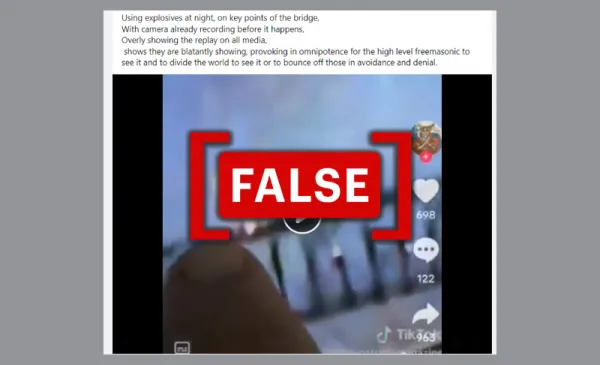By: Arron Williams
April 9 2024
 Source: Facebook
Source: Facebook
The Francis Scott Key Bridge in Baltimore collapsed after a ship collided with a support beam. There is no evidence explosives were used.
Context
The Francis Scott Key Bridge in Baltimore, Maryland, collapsed on March 26, 2024, after the Maersk container ship Dali collided with one of the bridge supports. The incident was designated as a "mass casualty event."
Following the bridge collapse, posts on Facebook and TikTok reshared a video that claimed that the collapse was actually a deliberate controlled demolition and that dynamite was used to detonate critical points of the bridge. Some posts make further claims suggesting that it is related to the Freemasons.
The original video from TikTok has been widely shared and shows a man pointing at various explosions along the bridge after the ship collided with the support. In the video, he claims, "You can see dynamite being let off at every single point."
Screen capture from the viral video pointing out purported explosions. (Source: TikTok)
However, the Francis Scott Key Bridge collapsed because the container ship collided with a bridge support. There are no news reports that suggest explosives were present.
In fact
According to AP News, the Dali cargo ship issued a mayday saying it lost power before it struck the support while traveling at roughly 9 mph. Roberto Leon, a Virginia Tech engineering professor, told AP News that the ship struck the support with significant force due to its weight. While the support can resist the impact by bending, it cannot absorb the energy brought by such a massive ship.
Container ship Dali striking the support of the Francis Scott Key Bridge, which caused it to collapse. (Source: YouTube/Voice of America)
In footage from The Guardian and NBC4 Washington, the bridge clearly collapses after the ship strikes the support. In the video pointing out purported explosions, the bridge is already collapsing from the ship striking the support when the "explosions" occur. There are no explosions or fires visible on the bridge before the collision.
The top screenshot, taken at 0:01 in the video, shows the bridge before it begins to collapse. The bottom screenshot, taken at 0:03 in the video, shows the first bridge section that begins to collapse. No explosions or fires are visible, and the bridge has already started to fall. (Source: YouTube/Guardian News)
In footage of the bridge collapse, several small "explosions" or fires are visible, which are pointed to as proof of a targeted demolition. However, as seen in NBC4's footage, the arch of the bridge contains several red lights that occasionally blink on and off. One of the "explosions" happens by one of these lights. The other fires also occur on this arch.
Screenshots with timestamps that show fires on the bridge arch. Both fires happen swiftly after the bridge first starts to collapse, as seen in the previous image. (Source: YouTube/Guardian News)
Dr. Kyle Perry, an Associate Professor of the Mining and Explosives Engineering Department at the Missouri University of Science and Technology, told Logically Facts, "To me, the fire with sparks appears to come from electrical cables being severed or pulled apart."
He then referenced the Guardian footage: "If you watch this video, on the left side of the screen, you will see a flash and then sparks around the 4-second mark. Just as that happens, the red light on top of the bridge to the left goes off. The sparks are a key indicator to me that it was not a high explosive like dynamite. High explosives produce a bright flash of light with some potential flash of fire if any combustible material is very close by."
He also explained that "dynamite isn't used to cut steel in demolition. Linear-shaped charges are."
Furthermore, the bridge collapse does not have similarities to controlled bridge demolitions. Footage of the controlled demolitions of the McClure Bridge, Pinto Creek Bridge, and an Autobahn bridge, all demolished by explosives, produced significantly more smoke and collapsed more evenly than the bridge in Baltimore.
Authorities and officials, including the Secretary of Homeland Security, have also stated that there is no evidence the bridge collapse was intentional or a terrorist act.
The verdict
There is no evidence that the bridge collapse was intentional or caused by explosives. "Explosions" seen around the bridge are sparks from power cables. Therefore, we have marked this claim as false.